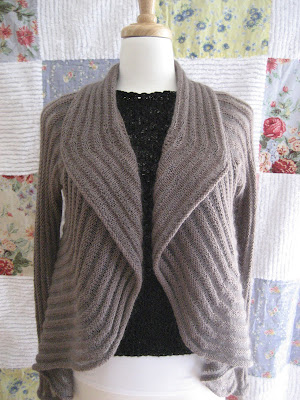Gosh Yarn It! I then wrote up the modifications and taught a three session class at GYI which ended in early May.
Class 1 -- Why? and how to start and how to steek.
Why? Creating a steek for the colorwork, allows you to knit the stranded Fair Isle in the round, which is so much easier than knitting it back and forth. (If you followed the Taiga pattern without this steek modification, you would be purling every other colorwork row with your floats in front.)
You might ask, why not knit the entire body in the round? I would answer that while that is not a bad idea, I did not want to lead (five) students through so very many changes (in a few different sizes). I would pretty much have to re-write the entire pattern. My greater goal was to provide a kind of quick-and-easy steeking experience, and to share the whys and hows of the knitting modifications that I made.
I considered that the steek stitches would be like a front facing after the garment was finished, and I decided to extend this facing from top to bottom. We added stitches (3 on each side) for the front facings beginning with the neck cast on. In the photo these facing stitches are on each end beyond the red stitch markers.
Until we got to the colorwork, the facing stitches were the only modification. At the start of the colorwork, one additional stitch was cast on to become the middle of the (7 stitch) steek. Then the work was joined to knit in the round. Steek stitches are more secure if you alternate colors in vertical stripes or in a checkerboard pattern.
After the last colorwork row, the center stitch was bound off. After one row, we turned the work and returned to knitting back and forth for the waist shaping rows.
Class 2 -- About the pockets... and be ready for steek cutting next time.
The "pocket facings" were knit next with the 3 extra stitches at each front edge. After they were finished and placed on a waste yarn, the back began with casting on 17 (20 less 3) stitches for "pocket linings" on each side. Before we began our lower ribbing, we knit the bottoms of the pockets closed (much like you would when working a 3 needle bind off). This knitting together begins with the 7th stitch from the edge of front facing and the first stitch of the pocket lining.
The bottom ribbing also had 3 extra front facing stitches on each end of row. The students worked to finish the ribbing before Class 3. For the sleeves, they were on their own, and could work on them before or after Class 3.
Class 3 -- Crocheted steek, and cutting the steek!
When I made Taiga #1, I first worked my crocheted steek with red yarn (for some instructional photos) and later replaced it with purple. My first instruction to my students was... Find the center stitch of steek. You may mark it with a pin. We will be crocheting half of this stitch to half of the adjacent stitch on each side. We will work from right to left.
With hook in position shown above, notice that it is inserted through half of a purple stitch and half of the green center stitch, you will first pull through a loop with your crochet yarn. Insert hook in next two half-stitches. Pull a loop of crochet yarn through them and the crochet yarn (all yarns on hook).
When we reach the end, we will rotate the piece and work back.
It is fairly easy to pull the crochet to each side for
cutting.
Four students cut their steeks in class that day! I am very proud of all of my students.
To end the class we went over the basic finishing including the front bands. I told the students to carefully determine a correct number of stitches to pick up for bands. I like to pick up 3 stitches for every 4 rows. (I would not pick up one stitch in each row as the pattern suggests.) You could also measure how many stitches are in one inch of your previous ribbing, and then calculate a total number of band stitches using a length-in-inches measurement of the front.
I am very glad to end this post, because I really must put my Taiga #2 away. It is 90 degrees outside! When I resume work on it this fall, I can post about my long sleeves (I knit them after the last class) and the zipper that I plan to sew into the front.
[ETA: I eventually posted in February 2014 about the sleeves, and in April 2014 about the zipper.]


















.jpg)







